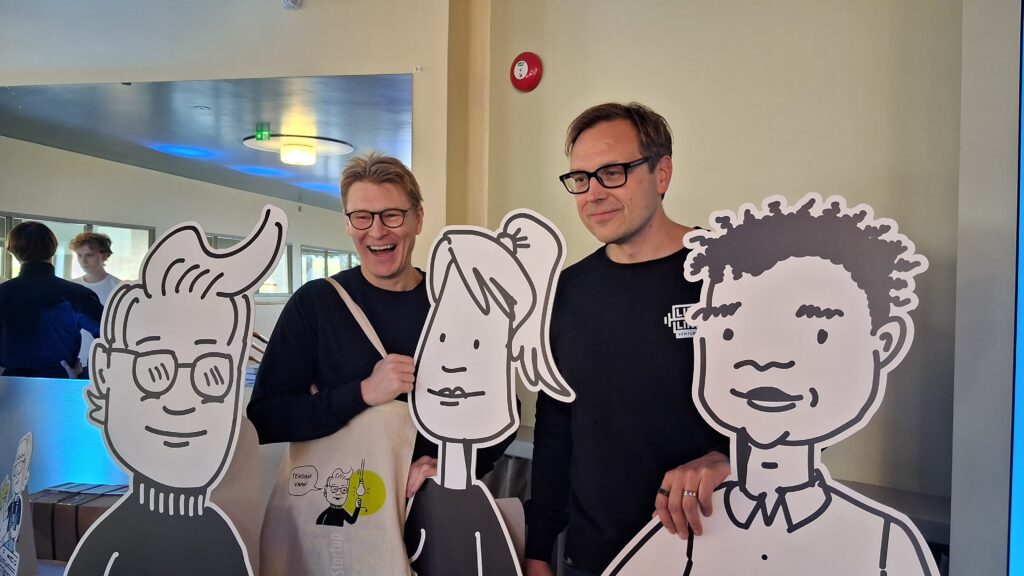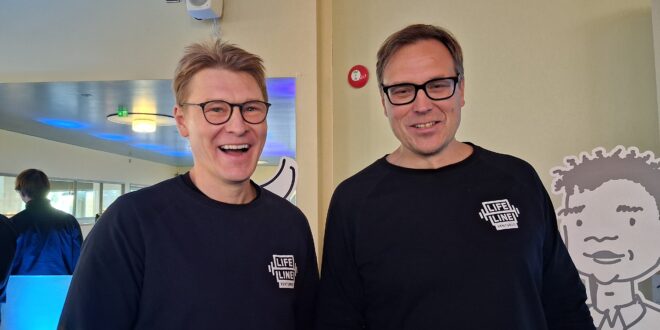HELSINKI – Startups have become an increasingly significant part of Finland’s exports. Experienced entrepreneurs and investors Jyri Engeström and Timo Ahopelto have written a handbook about startups for young people.
The book will be distributed for free to all third-year students in secondary education.
These men know what they’re writing about. Jyri Engeström cemented his place at the center of the Finnish startup community back in 2007 when he sold Jaiku, the company he founded, to Google.
Meanwhile, Timo Ahopelto’s medical research solutions company, CRF Health, became one of Finland’s first “unicorns” when it was first sold to a British private equity firm and later in a billion-dollar deal to the United States.

Jyri Engeström (left) and Timo Ahopelto co-wrote the initial and essential startup guide, The Startup Handbook.
Today, the men work at Lifeline Ventures, a company that has backed Supercell, Wolt, Swappie, and many other growth rockets. See the list at the end of the article.
If the goal is to get young people excited about startup entrepreneurship, what kind of elevator pitch would you use to lure them in?
“A person’s fundamental purpose is self-realization. And a startup is the best way to realize yourself during the hours you dedicate to your work,” says Ahopelto.
“We have a career map in that book. It says that if you are motivated by money and crayfish parties, maybe you should become a banker on Esplanadi (a street in Helsinki). But if you’re interested in building things, a startup is the best environment for that,” Engeström continues.
According to the men, the aim is to explain lightly how to found a startup and grow it into a giant like Supercell, Wolt, or Spotify.
The models are evident in various illustrated tests and, for example, a list of an entrepreneur’s most important gear. However, the book isn’t just a superficial overview—it delves into the details of investment agreements, option programs, and the practices of startup board work.
What exactly is a startup company?
For most people, a startup brings to mind a group of coders sipping energy drinks in Slush hoodies. However, the Startup Handbook describes founding and developing a growth company as a phased process that has largely repeated itself behind almost every success story cited.
Ahopelto suggests that young people should be taught about founding businesses like hair salons, driving schools, or construction companies. Startups, however, involve features that should be explored separately.
“A startup is a company aiming to become a global category leader in its own field. Entrepreneurship education in schools should focus more on these kinds of plans,” he says.
The surest way to become a global category leader is by revolutionizing, or “disrupting,” an industry. This is achieved by being clearly cheaper, faster than competitors, or by completely removing a laborious or difficult step.
The book’s example is McDonald’s, which revolutionized fast food by serving hamburgers to cars. Wolt and other delivery services, in turn, disrupted that model and brought the hamburgers right to people’s homes.
Disruption is a change that starts with an innocuous-looking startup but ends up changing everything.
The Startup Handbook
Another key difference between a startup and a traditional new business is financing. Seeking funding dictates the company’s growth and allows it to seize markets faster than would be possible with revenue or loan financing.
“A startup is about doing business with other people’s money. The entrepreneur brings the idea, and others bring the cash. In this area of entrepreneurship, you won’t lose your apartment if you go bankrupt,” Ahopelto adds.
Rising to a global success story is improbable, but investors are willing to pay for someone to try. Startup investors are not interested in a company that targets a small local market and plays it safe.
In fact, Ahopelto and Engeström argue in their book that the probability of success is always the same—regardless of the company’s level of ambition.
According to this claim, which they call the “basic axiom of entrepreneurship,” an ambitious goal attracts better employees, stronger partners, the most loyal customers, and more enthusiastic investors.
The book advises that a startup entrepreneur must choose a field they want to operate in and learn it so well that there are only a few people in the world who know it better.
The Startup Handbook will later be available in Swedish and English.
The entrepreneur must expose themselves to the work.
“And suddenly you notice that a new technology has emerged globally that allows you to develop a new solution,” Engeström says.
He also says he believes in the apprenticeship method. By this, he means that a startup career should start by going to work for a larger startup company.
“In companies like these, you learn from their founders. For example, Wolt founder Miki Kuusi initially went to work for Supercell and met Ilkka Paananen there, who became his mentor. Most of the founders of our best companies were first apprentices under the founder of another top company.”
“The only way to sustain society in its current form”
Startups are Finland’s hope. This claim has been heard before, but the book compiles evidence to back it up.
When the first Slush event was held in 2008, Finnish startup exports were about 0.3 billion euros; last year, according to the Startup Handbook, they were already nine billion. Over the same period, Finland’s total exports grew from 87 billion to 111 billion euros.
Based on this, the men calculate that over a third of Finland’s total export growth has originated from startup companies.
“And this has happened over the last 10–15 years. It is not a foolish idea for the nation to invest in the internet, artificial intelligence, and other emerging technologies. Because it is inevitable that a lot of value will be created there in the future,” Ahopelto says.
“In my opinion, it is the only way we can sustain this society in its current form.”
Engeström and Ahopelto say that Finland needs more unicorns. A unicorn is a startup company valued at over a billion dollars during a funding round, acquisition, or IPO.
According to Engeström, more unicorns are coming. Between 2019 and 2024, six Finnish growth companies crossed that magical benchmark.
“And we predict that during the next 5–6 year cycle, there could be ten to fifteen of them.”
Ahopelto’s and Engeström’s, plus et al Finnish venture capital firm Lifeline Ventures has raised its sixth and largest fund to date, at the size of EUR 400 million. This makes it the largest single VC fund in Finland focused on unlisted growth companies. The fund strengthens Finland’s growing role in Europe’s tech landscape and boosts the continent’s ability to scale its own success stories globally.
Tesi (Finnish Industry Investment) joins the fund as an investor with a significant commitment, marking its largest fund investment so far. The goal is to strengthen Finland’s venture capital and private equity market and elevate a domestic fund to a new scale.
#startup #suomi #finland #unicorn #wolt #supercell #spotify
 Nordic Startup News Early Stage Startup News From The Nordics
Nordic Startup News Early Stage Startup News From The Nordics


